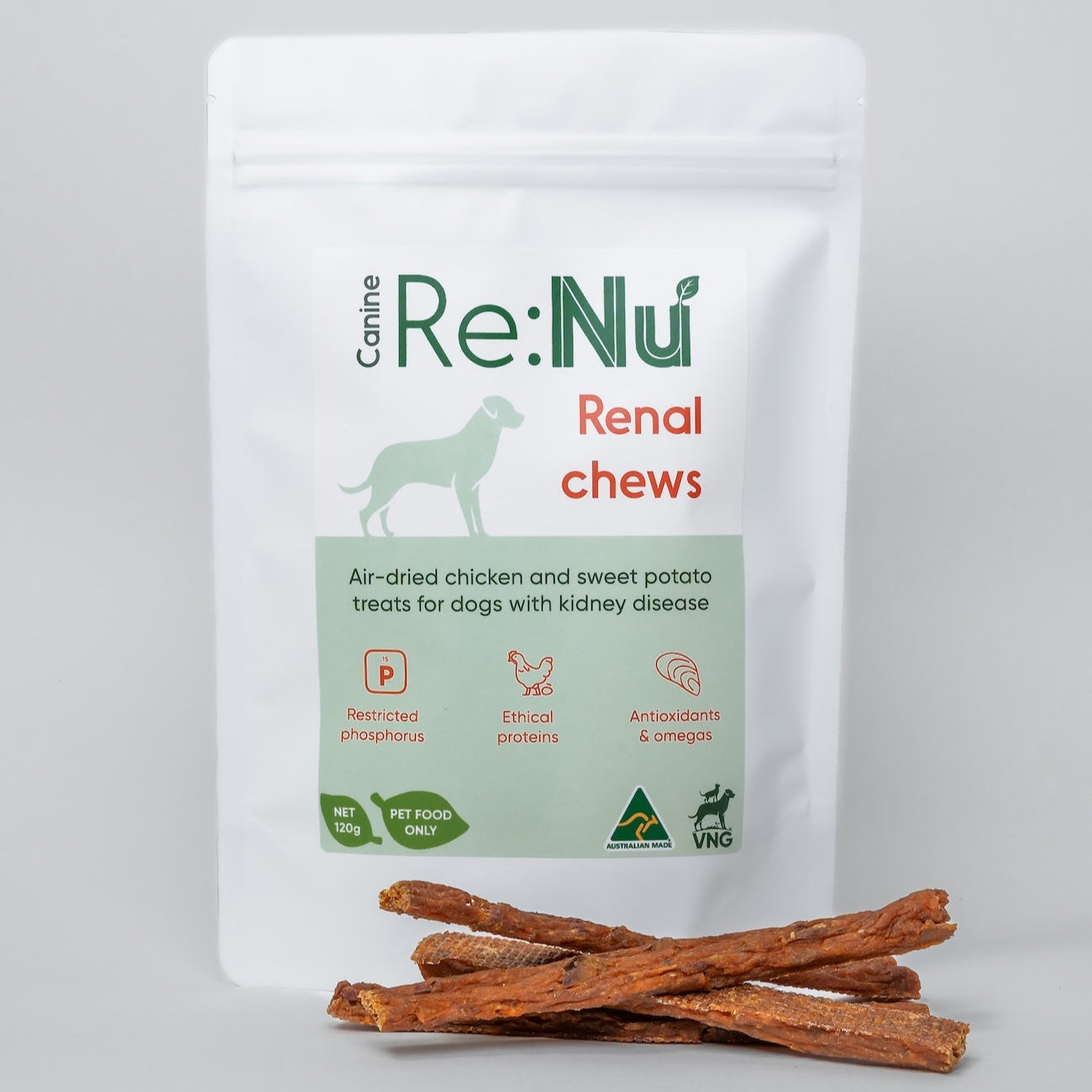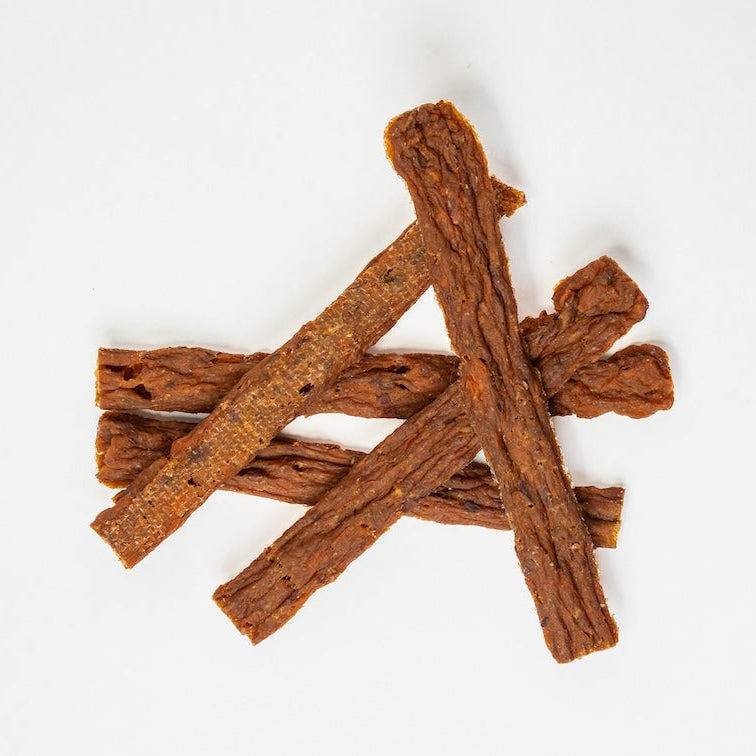
Feeding guide for puppies with kidney disease
With CompleteMe Puppy
Make low phosphorus, low protein therapeutic food for growing puppies at home quickly and easily.
Formulated for growing puppies, including large- and giant-breeds, with chronic kidney disease (IRIS stages 1-3).
Choose the meat, vegetables and other ingredients you would like to use with our simple, flexible guide.
Makes 1 kilogram of food.
Ingredients
250 grams of raw meat (2-10% fat)
500 grams of cooked starchy vegetables and/or grains
(choose from: baked sweet potato, baked potato, white rice, pasta, buckwheat, or pearled barley.
For any grains or pasta, please weigh out the required amount after cooking. For sweet potato and potato, please weigh out the required amount after baking)
190 grams of colourful non-starchy vegetables and/or fruit
5 mL omega-3 rich oil (5 x 1000 mg capsules)
(choose from fish oil, krill oil, salmon oil, or marine algae oil)
5 ¾ teaspoons of omega-6 and omega-3-rich oil
(choose from hemp seed oil, canola oil, or walnut oil)
5 grams of tasty fats
(choose from unsalted butter or ghee, natural yoghurt, tasty cheese, cottage cheese, olive oil, or coconut oil)
28 grams of CompleteMe Puppy
Optional:
1-2 tablespoons of:
- Fresh herbs such as parsley, basil, mint and coriander
- Bone broth
- Fermented vegetables (no chilli or garlic)
- Goats milk, natural yoghurt, or plain kefir
- Honey or maple syrup (maximum 1 teaspoon)
- Cooked whole egg (no shell)
- Dried ginger or turmeric (maximum ¼ teaspoon recommended)
- Boneless sardine or mackerel fillets, or cooked mussels, prawns or scallops
Directions
- Gently cook the diced meat in a pan with 50 mL water until cooked.
If using raw meat, please omit this step. - Steam or microwave the chopped vegetables until very soft.
If using sweet potato or potato as the starchy carbohydrate, please bake until soft and then weigh out the required amount. - If using grains or pasta, cook as per the manufacturer's instructions, then weigh out the required amount.
- Combine the cooked meat (including liquid from pan), cooked vegetables and/or grains, diced fruit, and oils, and mix well.
- Allow to cool then add 28 grams of CompleteMe Puppy and mix again.
- Portion and refrigerate, or freeze as desired.
Storage and safety
For homemade diets only
Do not add CompleteMe Puppy to any commercial dog food, or use with any other nutritional supplements (containing vitamins and/or minerals).
Raw feeding safety
For raw meat, freeze for 10 days before use to destroy parasites like Toxoplasma. In areas with Trichinella, please freeze pork for 3 weeks before use.
Storage and feeding
Larger batches can be made and frozen for convenience. Keep refrigerated food for 3 days, and frozen food for 3-4 months. Please discard any uneaten food after 30 minutes.
Feeding guidelines
Puppies with kidney disease have very different energy requirements based on their size, age, body condition, stage of disease, and activity level.
Toy/mini breeds (adult weight <5 kg)
- 1-2 months-old: 100-330 g
- 3-4 months old: 150-550 g
- 5-6 months old: 240-650 g
- 7-8 months-old: 230-700 g
- 9-10 months old: 120-500 g
- 11-12 months old: 110-350 g
Small breeds (adult weight 5-10 kg)
- 1-2 months-old: 200-600 g
- 3-4 months old: 250-800 g
- 5-6 months old: 350-1100 g
- 7-8 months-old: 450-1200 g
- 9-10 months old: 250-900 g
- 11-12 months old: 220-600 g
Medium breeds (adult weight 10-25 kg)
- 1-2 months-old: 350-800 g
- 3-4 months old: 450-1300 g
- 5-6 months old: 600-2000 g
- 7-8 months-old: 800-2200 g
- 9-10 months old: 440-2000 g
- 11-12 months old: 350-1100 g
Large breeds (adult weight 25-45 kg)
- 1-2 months-old: 450-900 g
- 3-4 months old: 650-2500 g
- 5-6 months old: 1000-3200 g
- 7-8 months-old: 1300-3600 g
- 9-10 months old: 1000-4000 g
- 11-12 months old: 750-3700 g
- 12-14 months old: 700-2500 g
- 15-16 months old: 700-1800 g
Giant breeds (adult weight 45-80 kg)
- 1-2 months-old: 600-1500 g
- 3-4 months old: 1300-3300 g
- 5-6 months old: 2000-4100 g
- 7-8 months-old: 2200-4500 g
- 9-10 months old: 2500-5500 g
- 11-12 months old: 2300-6000 g
- 12-14 months old: 1300-6700 g
- 15-16 months old: 1100-6000 g
- 17-18 months old: 1000-5800 g
- 19-20 months old: 1000-4500 g
- 21-22 months old: 1000-3500 g
- 23-24 months old: 1000-2800 g
Feeding quantities are estimates, and are based on fresh food which contains significantly higher moisture than dry food.The energy density of the diet will also change depending on the ingredients you select (lower fat = less energy dense = more food is needed).
We recommend feeding multiple meals per day, depending on age. Using puppy growth charts can be helpful in monitoring for too rapid or stunted growth. Discuss with your veterinarian ways to ensure your puppy is growing at their optimal rate.
Learn how to quickly body condition score your puppy here.
Nutritional information
Formulated to meet the FEDIAF Nutritional Guidelines for late growth (puppies older than 14 weeks, including large and giant breeds).
Not recommended for adult dogs with kidney disease; please use our feeding guidelines for adult dogs with early or advanced kidney disease).
All possible combinations of the ingredients listed above have been checked to ensure that the diet contains moderate to low protein, moderate fat, controlled calcium, phosphorus and sodium, and is enriched with omega-3 fatty acids, antioxidants, and fibre.
Please note that the phosphorus content of the diet meets the FEDIAF recommended minimum for growth, to allow for normal skeletal growth. Greater restriction may be advisable, depending on the puppy's age, size, and stage of disease. Please contact us for more information.
The average kcal/gram for the diet is: 1.2 kcal/gram
The average protein for the diet is:
On a dry matter basis: 22%
On a caloric basis: 52 grams per 1000 kcal ME (or 21% calories from protein)
The average fat for the diet is:
On a dry matter basis: 15%
On a caloric basis: 35 grams per 1000 kcal ME (or 28% calories from fat)
Average phosphorus for the diet is:
0.73% dry matter basis
1.74 g per 1000 kcal ME
Average calcium for the diet is:
1.1% dry matter basis
2.6 g per 1000 kcal ME
The average calcium to phosphorus ratio is 1.5
The average moisture content is 70%
FAQs
What meat can I use?
Skinless and boneless chicken thigh or chicken breast
Lean pork mince or diced pork loin with 5-10% fat
Extra-lean diced lamb or goat meat (including heart) with 5-10% fat
Lean venison fillet or steak
Extra-lean (5 star) beef mince or gravy beef with 5-10% fat
Skinless and boneless turkey or duck breast
Lean kangaroo mince or steak with 2-3% fat
Skinless and boneless white fish fillets, like whiting, hoki, ling, or barramundi (don't feed fish exclusively)
Which vegetables and fruits are safe for puppies with kidney disease?
Important note: Some puppies with more advanced kidney disease can develop high potassium in their blood (hyperkalaemia).
If your puppy has hyperkalaemia, feeding a diet with lots of potassium-rich vegetables may not be suitable. Please contact us at info@vngpets.com for more information on personalised, low-potassium recipes.
For vegetables, try pumpkin, broccoli, cauliflower, green beans, green peas, carrot, zucchini, squash, spinach, kale, turnips, parsnips, watercress, Asian greens, mushrooms, tomato, capsicum or cabbage.
Both fresh and frozen vegetables are fine. We recommend steaming or microwaving for most vegetables, however baking can also work well sometimes.
For fruit, try strawberries, blueberries, raspberries, apple, pear, banana, mango, peach, plum, kiwifruit, guava, papaya, pineapple, watermelon, rockmelon or honeydew melon. Please be very careful to remove any pits or stones, and avoid toxic fruit like grapes, raisins or currants.
How can I store the food?
This makes just over 1 kilogram of food, which can be portioned and fed immediately, or stored in the fridge (max 3 days) or freezer (max 3 months) until needed.
Is this safe for giant-breed puppies like Great Danes or Irish Wolfhounds?
Yes, the diet has been formulated to be safe for puppies of all sizes and breeds, from 14 weeks of age onwards.
Can I use raw meat?
You can include the meat raw or cooked, depending on preference. For raw human-grade meat, be sure to freeze the meat for 10 days prior to use. For pork (in areas with Trichinella, freezing for 3 weeks prior to use is sensible. Please discuss raw-feeding with your dog's veterinarian; raw feeding is not suitable for all dogs or households and may be a particular concern for puppies with medical conditions.
Which are the lowest phosphorus combinations?
The average phosphorus content of the diet just meets the FEDIAF recommended minimum for late growth (puppies from 14 weeks onwards). Meats with a fat percentage of 4-6% will achieve this.
For lower phosphorus meals, choose meats with higher fat (6-10%). We would recommend this for small to medium-breed puppies older than 8 months.
For higher phosphorus meals, choose meats with lower fat (2-5%). We would recommend this for large or giant breed puppies 3.5-6 months old.
My dog has allergies, can I use novel proteins like emu or crocodile?
Yes, using novel proteins is fine. Please select proteins with 2-10% fat only. Some options could include:
Emu fan or flat fillet, or full rump
Crocodile tail or leg meat
Venison mince, fillet or steak
Wild boar shoulder (deboned) or mince
Lean diced boneless goat (visible fat trimmed off) or mince
Leaner proteins like diced venison, crocodile meat, or emu meat, will produce a diet higher in protein and phosphorus. This may not be optimal for puppies with more advanced disease and/or older small-breed puppies.
All puppies need great training treats


Re:Nu Renal chews
Therapeutic treats for dogs with kidney disease.
Delicious air-dried chews for dogs with restricted phosphorus and protein. Specially formulated in-house by our Board Certified Veterinary Nutritionists.
These treats are also low in fat. They contain free-range chicken and egg white, antioxidant-rich sweet potato and berries, and added green-lipped mussel.
Size: 120 grams
